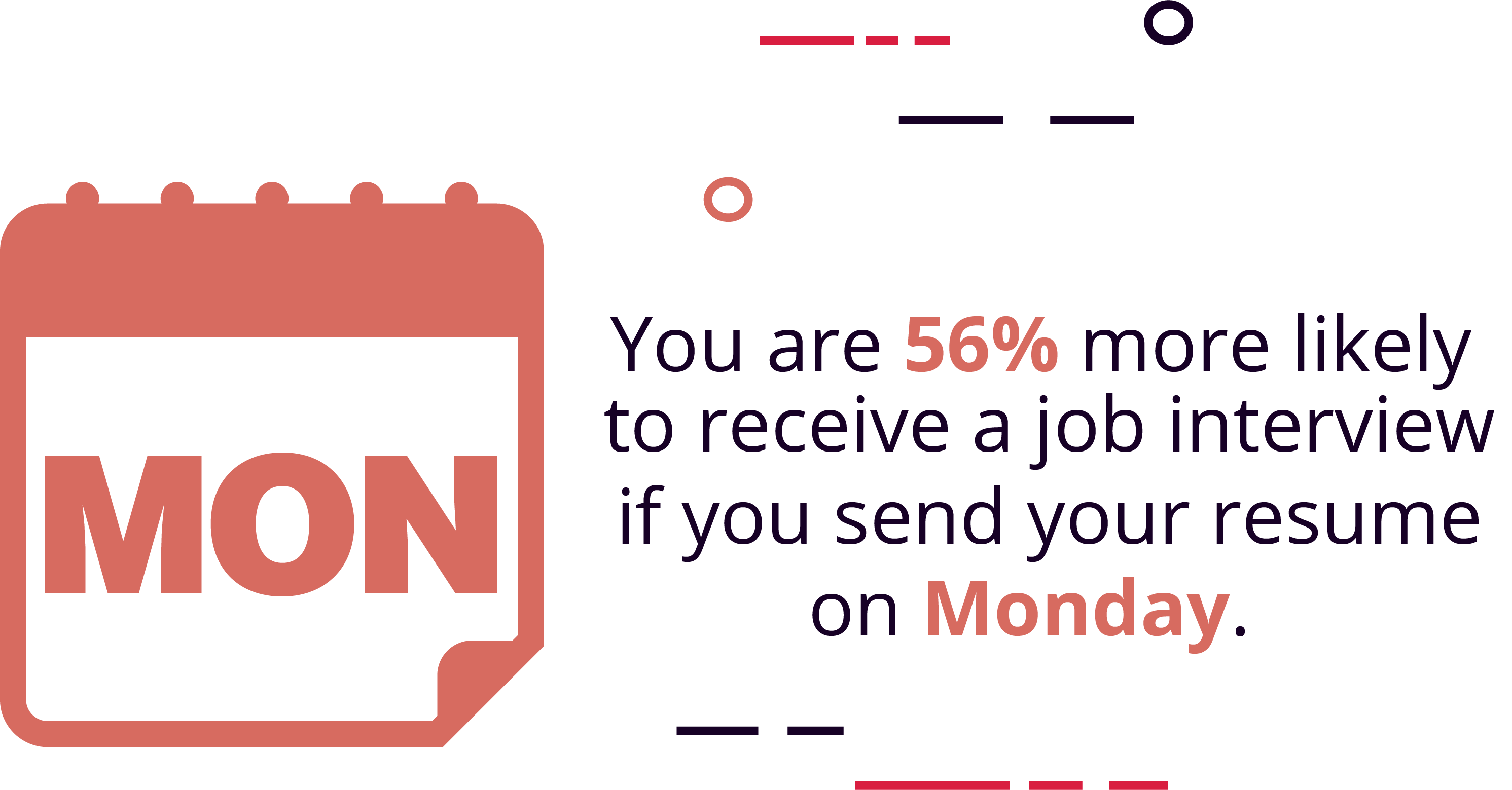Searching for a job is hard. It is even more difficult because there are tons of small things that can affect whether your resume gets looked at or gets tossed into the recycling bin.
Something as unassuming as serif fonts can make recruiters less likely to look at your application.
With that in mind, we present you a list of 60 job search tips that are backed by science and will help you increase your odds of being hired.
1. 68% of Hiring Managers Spend Less Than 2 Minutes Looking at a Resume
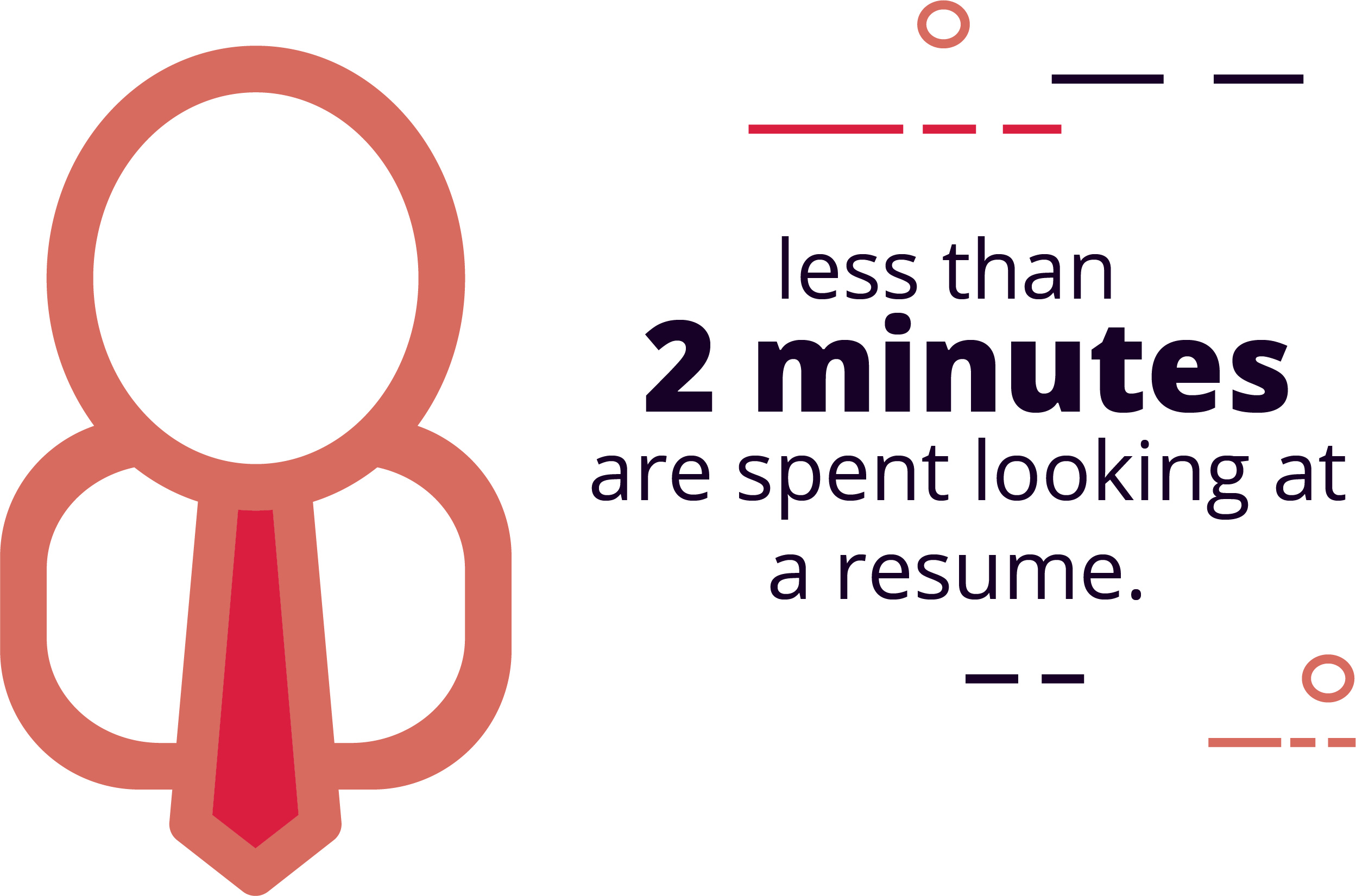
We know you spent all that time and effort into making a resume and most people probably won’t take more than a passing glance at it.
The truth is most hiring managers only look for some keywords and phrases rather than reading all the text and most only spend a maximum of 2 minutes looking at resumes [1].
That is also why a shorter resume is probably a better idea. Hiring managers don’t have the time to read through dense complex descriptions.
2. 92% of Recruiters Look at Candidates’ Social Media Pages
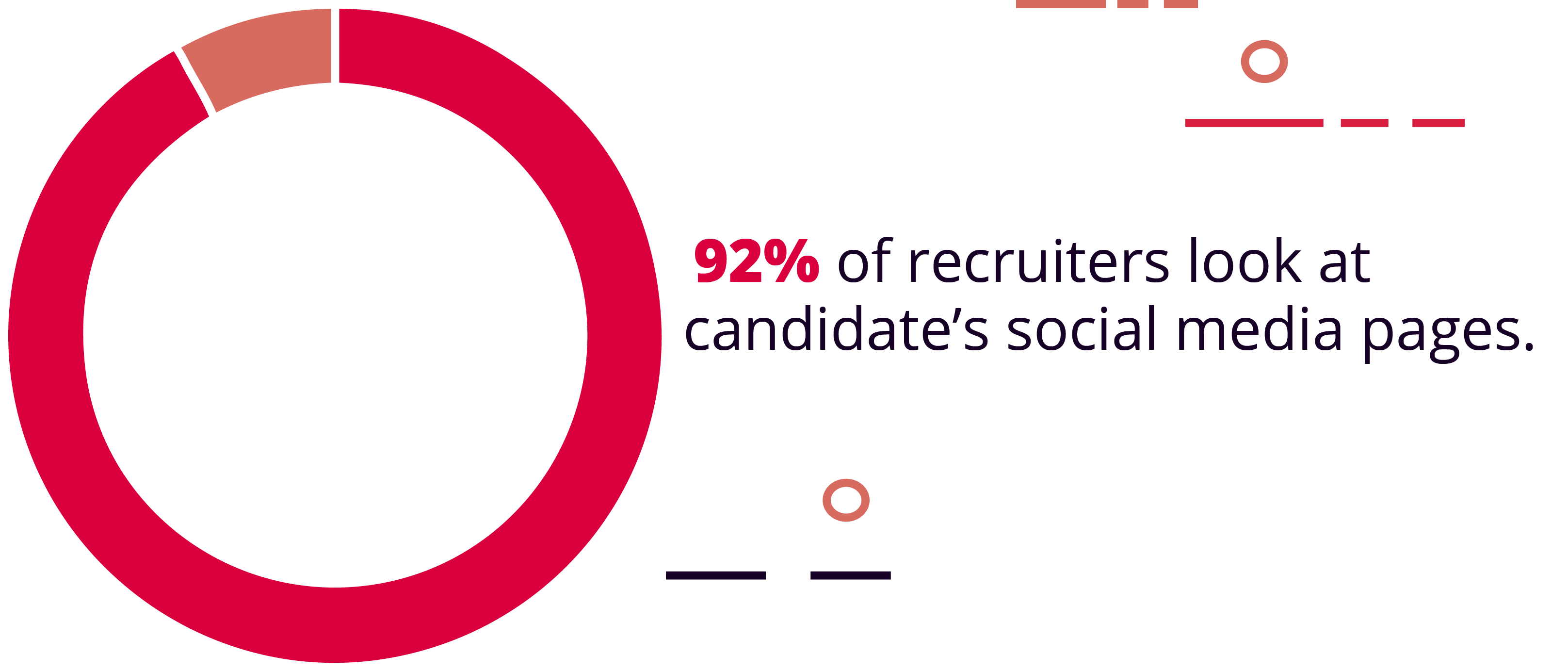
92 percent of recruiters and hiring managers look at candidates’ social media pages to get information [2]. So you should not only take some time to clean up any unsavory details from your social media pages, you can turn them into a sort of resume all on their own.
Social media pages also tell recruiters how well connected in an industry you are.
3. The Most Common Social Media Page Looked at Is Linkedin
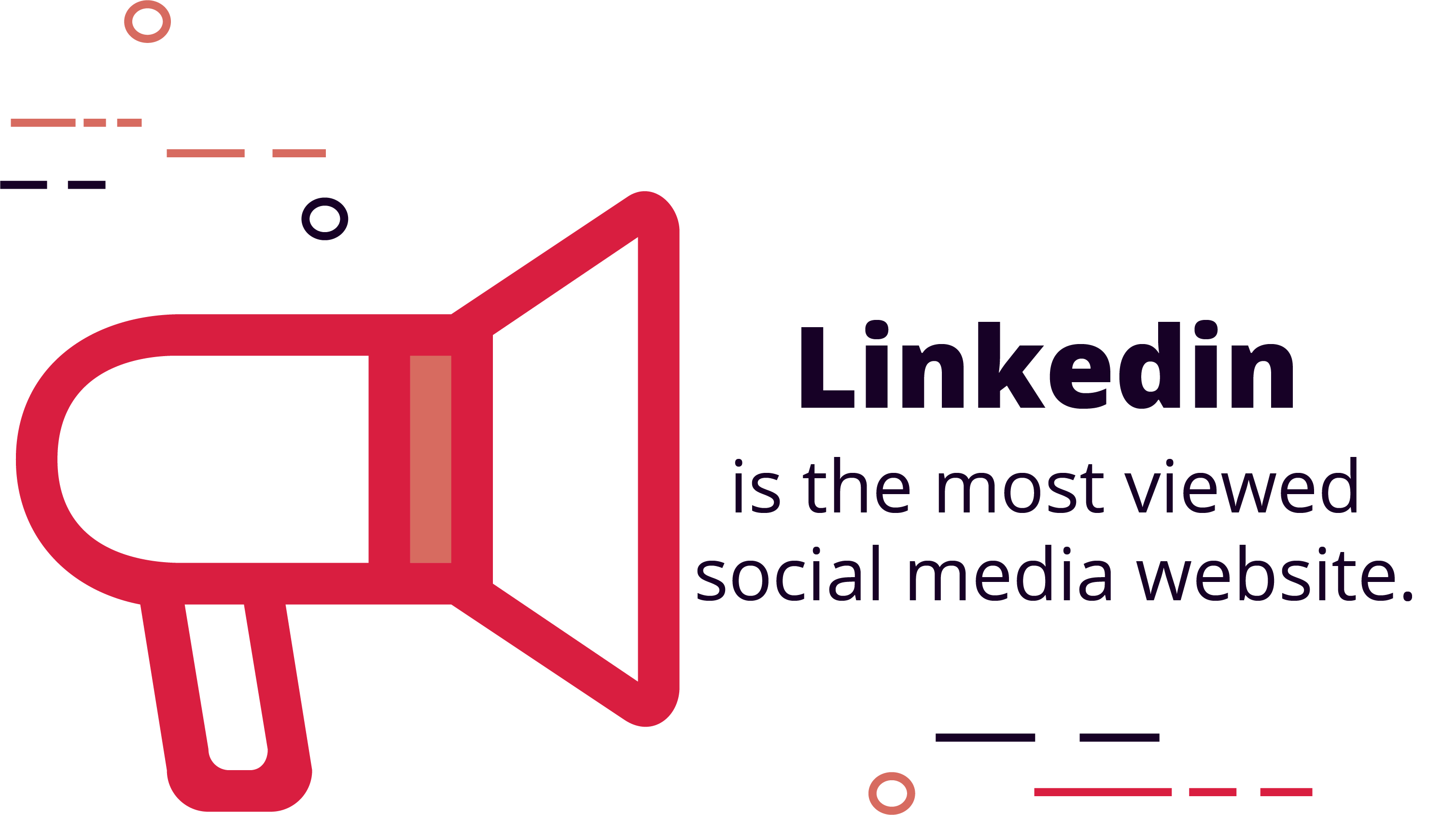
According to the same survey, recruiters and hiring managers most commonly looked at LinkedIn.
Over 87% of recruiters who use social media looked primarily at LinkedIn with Facebook and Twitter next at 55% and 47% respectively.
The two social media pages looked at the least were Instagram (13%) and Snapchat (3%) [2].
Other social media pages looked at but not recorded in the survey results were Vimeo, Tumblr, Pinterest, and Periscope, among others.
In general, the more active a person was on social media, the more social media pages were a factor consulted during hiring
4. Referrals Are the Largest Source of Quality Hires
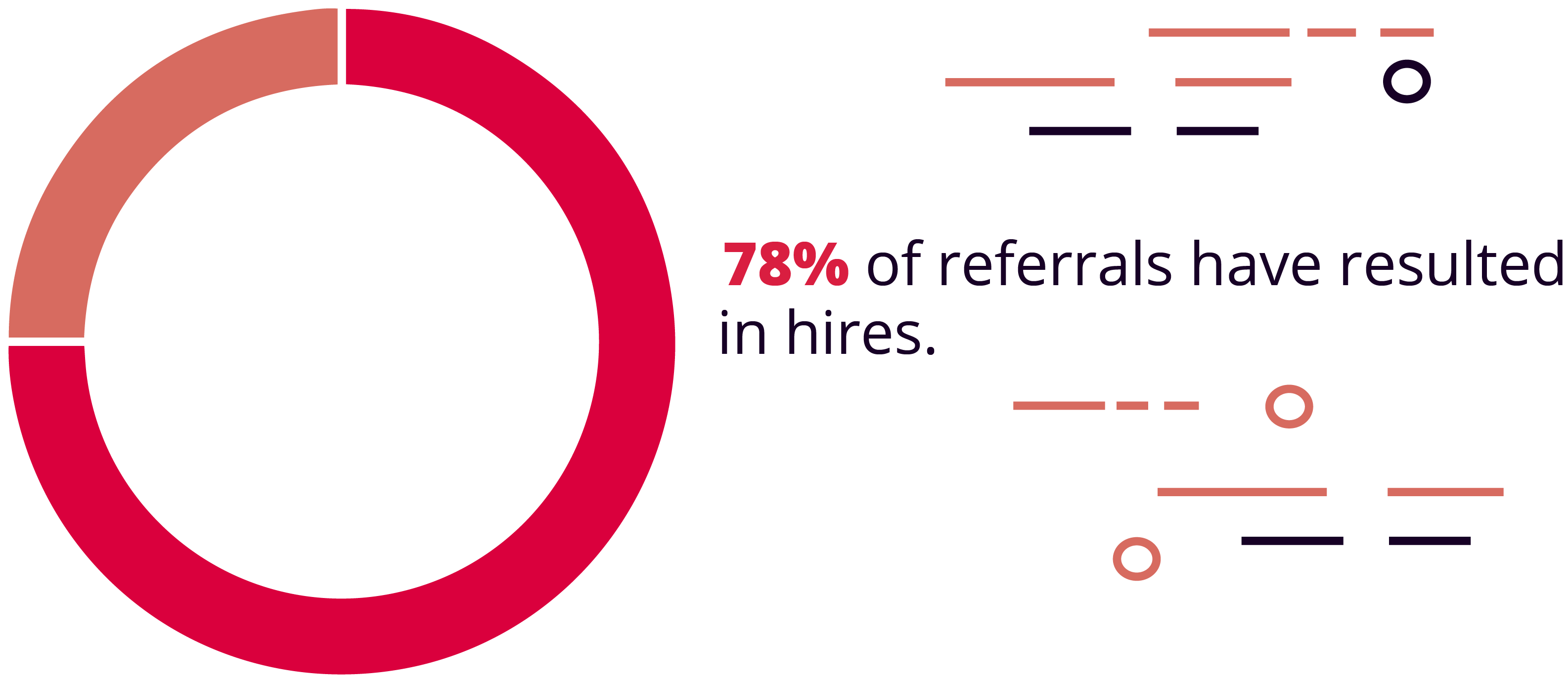
It may come as no surprise, but referrals are still the top source of quality hires.
Over 78% of referrals resulted in hires, either from within or outside the company.
The next largest source of hires was social media networks at 58% and mobile career boards sitting at the lowest spot at 19%. Internet job boards had a hire rate of 37% and direct applications 46%.
Perhaps surprisingly, outside recruiters had a relatively low rate of hires at only 38%, lower than from interns at 55% [2].
5. The Average Job Opening Receives 250 Resumes

The job market is more competitive than ever and candidates vie for limited spots.
The average job opening gets 250 resumes from candidates [3].
That is why it is more important than ever to craft a resume that really pops and catches the attention of hiring managers.
Further, the same survey found that usually only 4 to 6 applicants were called for an interview for each job opening; a 0.016% interview rate.
When we say competitive we mean competitive.
6. It Takes a Company an Average of 42 Days to Fill a Position

It takes an average of 42 days for a company to fill a position from opening the position to accepting a hire [4].
Generally, it took companies two to three weeks to schedule the first interviews with candidates. Further, the average employment tenure across all industries was 8 years with 5 years in the 25th percentile and 11 years in the 75 percentile. The majority of turnovers were voluntary at 13%.
7. Industry Buzzwords Increase Hireability by 29%

The proper use of keywords, industry buzzwords, and jargon on your resume can increase your chances of being hired by almost a third [5].
Apart from the usual reasons, specialized jargon and language help get you past any automated screening tools so your resume will actually end up in the hands of a human rather than being chucked in the rejection bin off the get-go.
Make sure not to go overboard though, or else the hiring manager may think you are a robot.
The ideal ratio is to name-drop a buzzword every 3-6 sentences, just enough to keep hiring managers’ attention but not so much it sounds forced and fake.
Words like “achieved,” “compiled,” “facilitated,” and “negotiated” are all eye-catching buzzwords that have a lot of professional importance.
8. Generic Adjectives Will Hurt Your Chances

You need to make your resume stand out from the crowd and using boring cliche language is a sure-fire way to get your resume lost in the pile with all the others.
Unfortunately, everyone is trying to make themselves sound special and qualified which ironically has the effect that everyone sounds the same and non-unique.
Every year, LinkedIn publishes a list of their top 10 overused words in resumes. According to last year’s results, the single most overused words on resumes was “specialize” followed by “experienced”, “skilled”, and “leadership” [6]. Everyone is guilty of using a few of these generic descriptors every now and then, but try to keep them out of your resume or use more unique synonyms.
9. 87% of Hiring Managers Think Previous Work Experience Is the Most Important Factor

Over 87% of recruiters and hiring managers said that previous job experience was either the most or one of the most important things when assessing a candidate [2].
This makes sense; after all, your job history is likely the best indicator of whether you can actually do the job.
So when writing your resume, makes sure you focus mostly on your past work history and how that shows you are qualified for the position in question.
10. 87% of Recruiters Remember Enthusiasm

Among factors that left a lasting impression, 87% of recruiters reported that they remembered candidates the most when they showed a lot of enthusiasm [2].
In fact, candidate enthusiasm left a bigger impression on recruiters than either industry knowledge or conversational skills did. So when writing your resume, craft each sentence so your enthusiasm shines through.
Even if your skillset is slightly lacking, a stellar personality can make recruiters remember and hold on to your resume.
Other important features that left a lasting impression on recruiters were punctuality, appearance, and handshake/greeting.
11. Hiring Managers Spend an Average of 7.4 Seconds Looking at a Resume
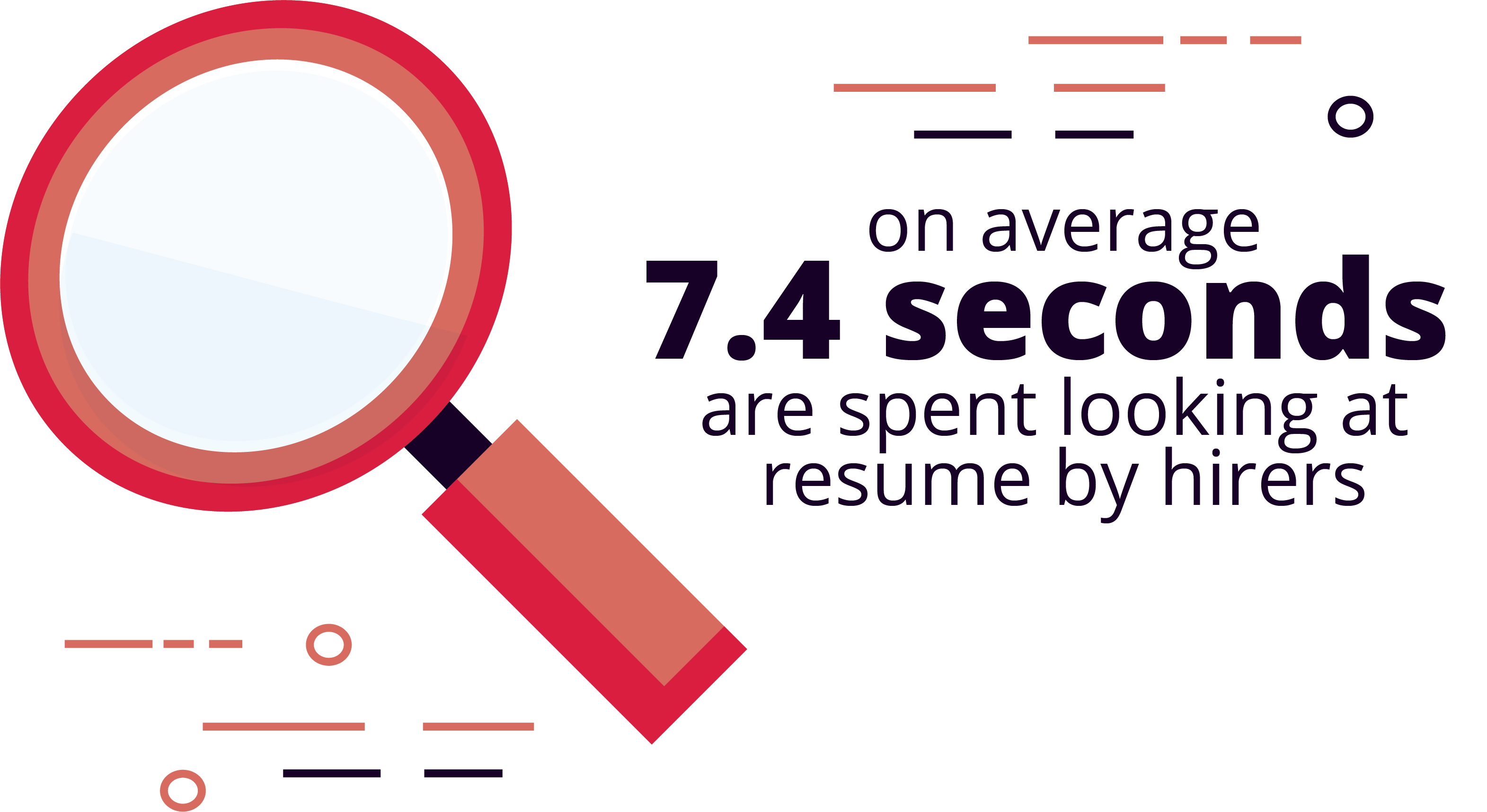
A 2018 eye-tracking study by Ladders determined that recruiters spend an average of 7.4 seconds skimming a resume [7].
The same study found that recruiters looked at resumes longer when they had clean simple layouts, title headers and bullet points, an overview or a mission statement on the first page, and clear fonts without serifs.
Conversely, the resumes recruiters spent the least amount of time looking at were cluttered, had little to no lists or bullet points, and overloaded keywords and industry buzzwords.
Resumes that were received poorly also had long run-on sentences while those that were successful had shorter declarative sentences.
12. Sales Positions Get Hired First
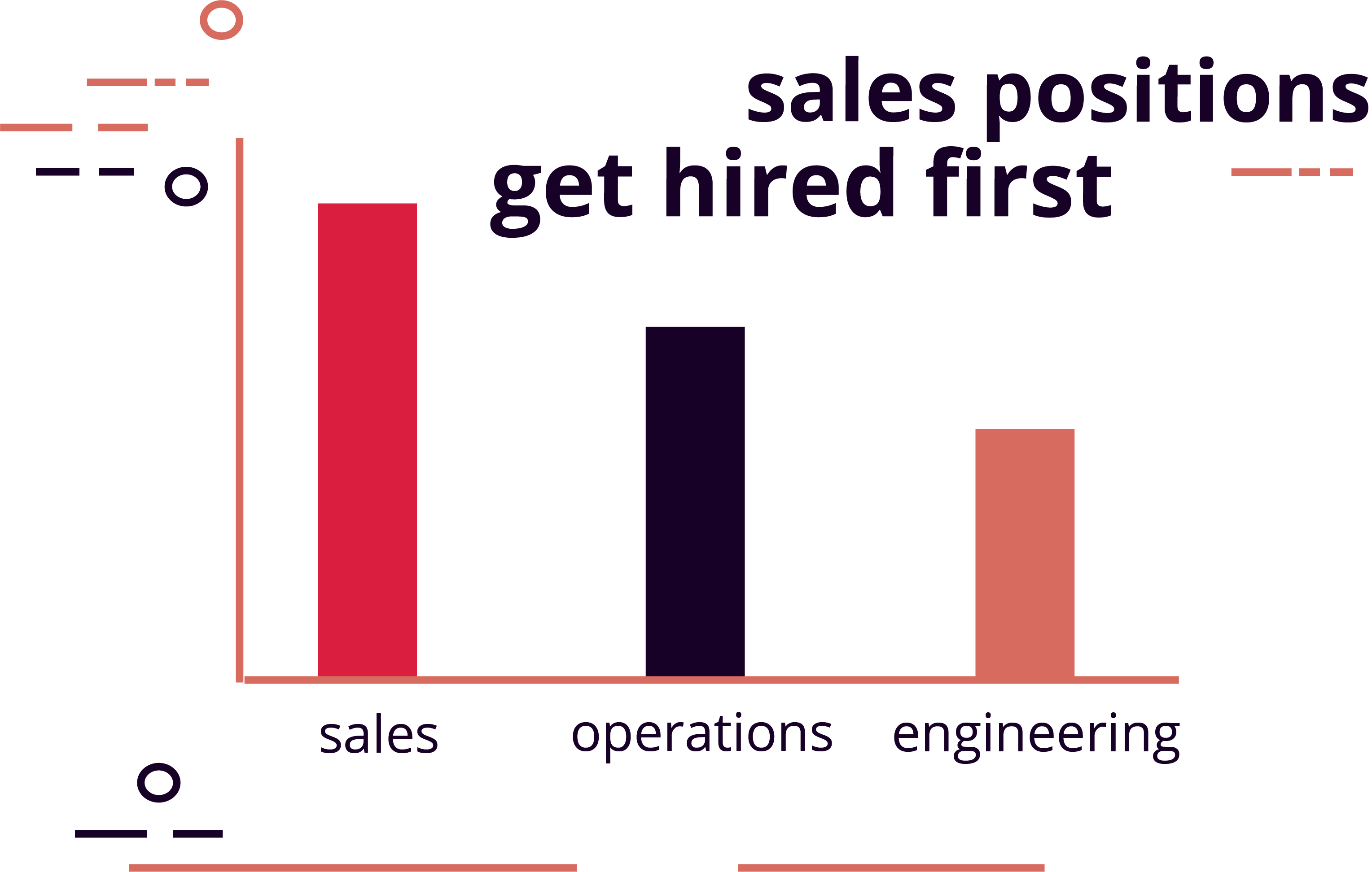
Sales positions are a priority at most companies and are among the first and quickest positions to get filled, followed closely by operations and engineering, and information technology and business development in 4th and 5th respectively [8].
Given that so many companies subsist on providing consumers products, it makes sense that sales and operations positions would be among the quickest and highest priority hires.
Sales positions were filled an average 1 ½ times faster than operations positions and nearly twice as fast as engineering positions.
13. 75% of Recruiters Use Recruiting Software When Hiring

In the past, you could send in a physical copy of your resume and, while you may not get the job, you could at least be certain it would at least touch the hands of a real human being at some point.
In today’s electronic dominated world, more recruiters rely on electronic resume submissions and use recruiting software to comb through the hundreds of resumes they receive each day.
Over 75% of surveyed recruiters reported they used recruiting software or applicant tracking software in the hiring process [9].
These kinds of programs automatically sort through resumes based on key characteristics such as employment history and the presence of certain keywords and phrases.
14. The Biggest Challenge Facing Recruiters Is a Lack of Qualified Candidates

56% of recruiters reported that a lack of skilled/qualified candidates was the largest obstacle to hiring [2].
Recruiters and hiring managers receive tons of resumes every week but the problem is that a small percentage of them are actually any good.
Other factors that got in the way of hiring were competition amongst candidates, lack of budget for hiring, and location. The severity of each factor differed depending on the industry. For example, 93% of recruiters in the hospitality industry found a lack of skilled workers to be a huge problem, while 28% of midwestern recruiters found that location got in the way of hiring practices.
15. You Are 46% More Likely to Be Hired If You Apply on a Monday
Candidates have an almost 46% higher chance of being hired in they apply on a Monday compared to other days [10].
The worst day to apply by far was Friday on which the interview rate was less than half the rate from resumes received on Monday.
This trend may be because on Mondays hiring managers and recruiters are just getting the week started and have more energy, while on Friday they likely just want to hurry up and go home for the weekend.
16. Using Personal Pronouns Can Make You 58% Less Likely to Get an Interview

Using personal pronouns reduced hireability by almost 60% [10].
Even if a person used just one personal pronoun, they were 58% less likely to get a callback interview.
Personal pronouns make your resume sound informal and recruiters may mistake that for a lack of professionalism.
So stay away from personal pronouns (I, you, he, she, me, etc.).
Don’t use them at all, not even once!
17. Adding a Photo Can Increase Chances of Rejection by 80%

While not exactly standard resume etiquette, it may be surprising to know that including a picture of your face with your resume increases your chances of being rejected by almost 80% [11].
We are not really sure why this is the case, but the data seems to imply you are better off letting leaving out any photos.
Perhaps recruiters see photos as unnecessary and unprofessional or maybe pictures distract from the important parts of your resume.
18. 40% of Hiring Managers Want a Cover Letter

While it may sound basic, you would be surprised how many people forget to send in a cover letter.
45% of job seekers actually fail to send in a cover letter while over 40% of recruiters report they want to see cover letters [12].
A good cover letter should consist of a quick description of your work history, how you heard about the position and a short summary of your skills and career accomplishment.
Make sure you don’t seem overeager and you do not over exaggerate your accomplishments.
Recruiters are pretty good at picking out when job candidates are full of it.
19. 61% of Recruiters Discard a Resume If It Has Any Typos

Again, it sounds like common sense but proofreading your resume is very important.
61% of recruiters will outright dismiss a resume if it contains any typos [12].
Typos not only reflect poorly on your organizational skills and attention to detail. It also indicates you did not take time and effort into writing your resume, which reflects negatively on your motivation.
Common typos in resumes include missing articles, improper punctuation, run-on sentences, and improper formatting.
20. Recruiters Are 22% More Likely to Remember a Cover Letter If It Addresses Them by Name

If you know the name or names of the hiring managers, address them by name in your cover letter.
84% of job seekers do not include recruiter names in their resumes, though 22% of recruiters pay more attention if their name is included [12].
It is somewhat counterintuitive that addressing recruiters by their first name helps your resume while using personal pronouns seem to hurt your chances, but that is what the data suggests.
Appealing to first names may come off as more informal, but also more personal and approachable.
21. 75% of Hiring Managers Have Caught a Lie on a Resume

Almost everyone is guilty of exaggerating their accomplishments on their resume.
A little bit of exaggeration can go a long way. But you definitely want to avoid making up credentials or lying about your experience.
3 in 4 HR managers (75%) report that they have caught a lie on a resume [12].
Job recruiters can tell if you are lying if your job descriptions are vague or if your descriptions of your skills are not comprehensive.
Job recruiters are also good at reading body language to pick up on when candidates are embellishing their accomplishments.
22. Failing to Send a Follow up Message Can Hurt Your Chances by 37%
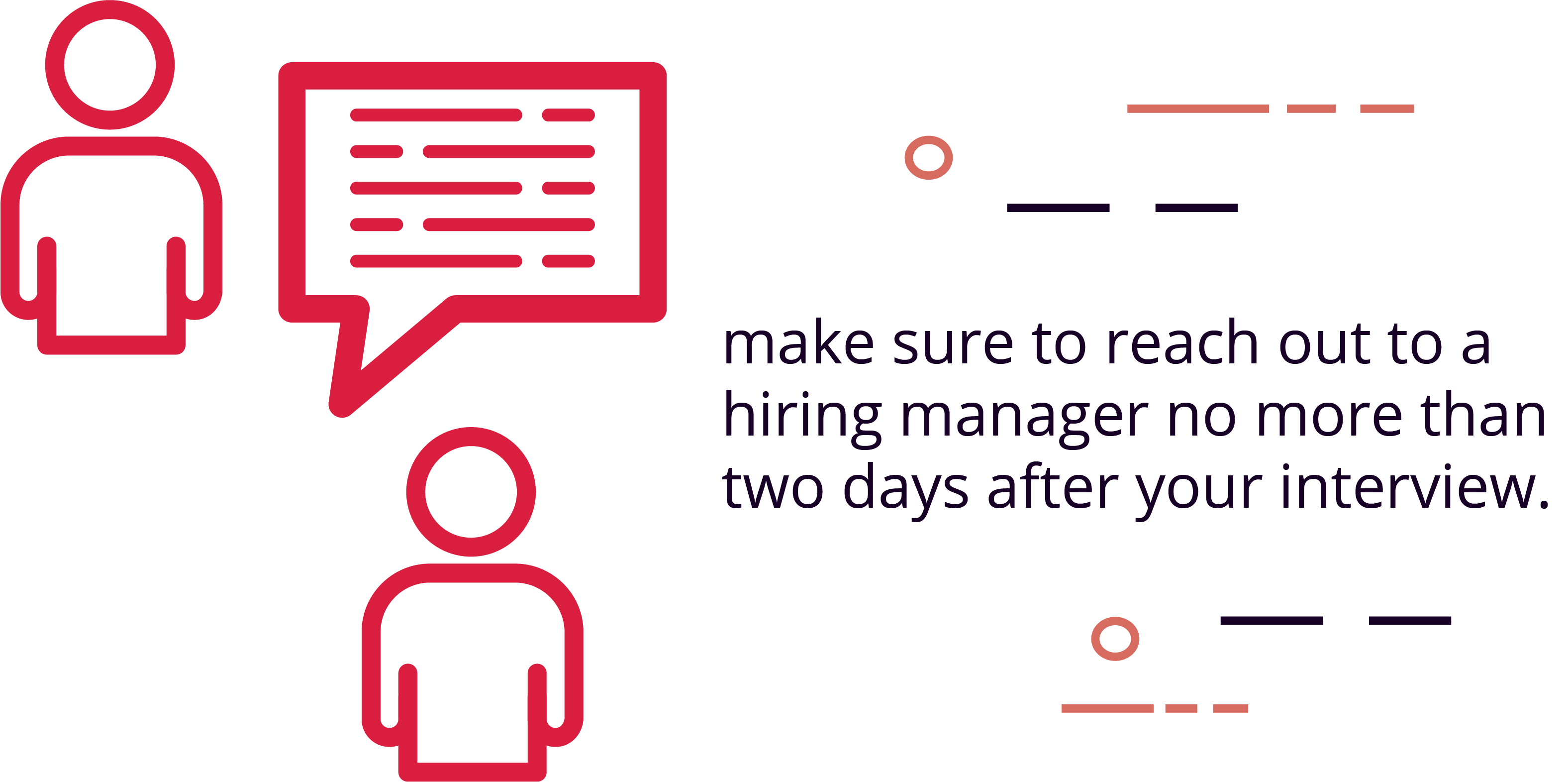
37% of recruiters rejected resumes because candidates did not send a follow-up message after an interview [13].
So make sure to reach out to hiring managers no more than 2 days after you show up for an in-person interview.
Doing so will help recruiters remember your face and reiterate your interest in the position.
Recruiters want people who actually want the position so showing them continual interest is a great way to make a good impression.
23. Using Action Verbs on Your Resume Makes You 140% More Hireable

Starting sentences on your resume with action verbs (build, maintain, write, run, act, fix) can increase your chances of being hired by a whopping 140% [10].
Describe your tasks and experience using sentences that begin with action words.
Avoid the passive voice wherever possible.
Here is an example:
Instead of:
“A comprehensive database of employee records was created by me.”
Say:
“Created a comprehensive database of employee records.”
Placing the verb before the subject gives your sentences a good momentum that makes them easier to read and more to the point.
24. 60% of Recruiters Are More Likely to Look at a Resume If It Is Customized for the Position

60% of recruiters said that they were more likely to look at a resume that has been customized to the specific position [12].
When job hunting, a lot of people just copy and paste the same resume for each application.
While this is easier, it can come off as if you do not really care about the position very much.
Try to write your resume for a specific position. Focus on elements of your work history and skillset that are relevant to the position and modify your cover letter accordingly.
25. 25% of Hiring Managers Think Community Service Is Important on a Resume
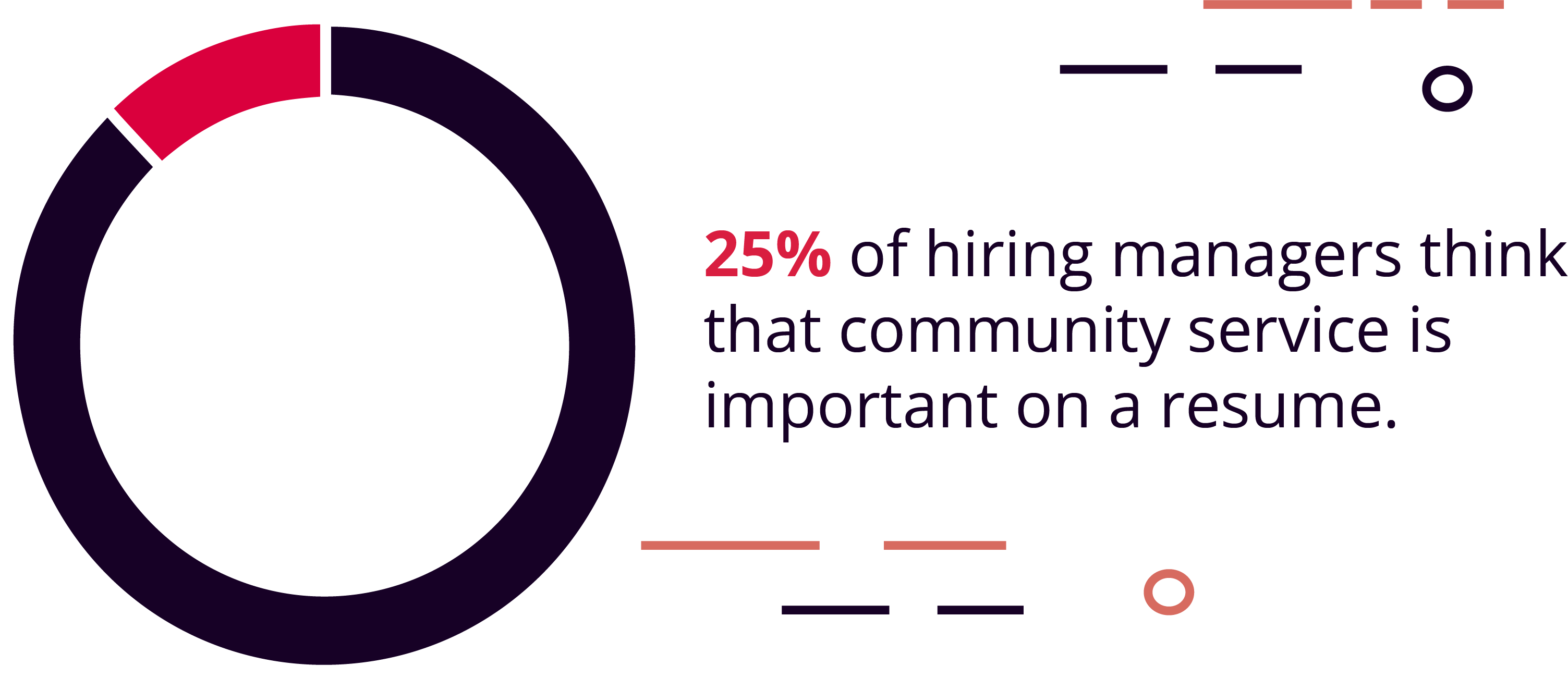
Even though previous work experience is the most important factor for hiring managers, over 1 in 4 managers said that a history of community service would make them more likely to hire a candidate [12].
Community service shows employers that you are interested in and invested in giving back to your community and can serve as a positive social force at their company.
Recruiters also reported that a good sense of humor is also something that would make them more likely to hire one candidate over another.
26. Having a Second Degree Boosts Your Chances of Being Hired by 22%
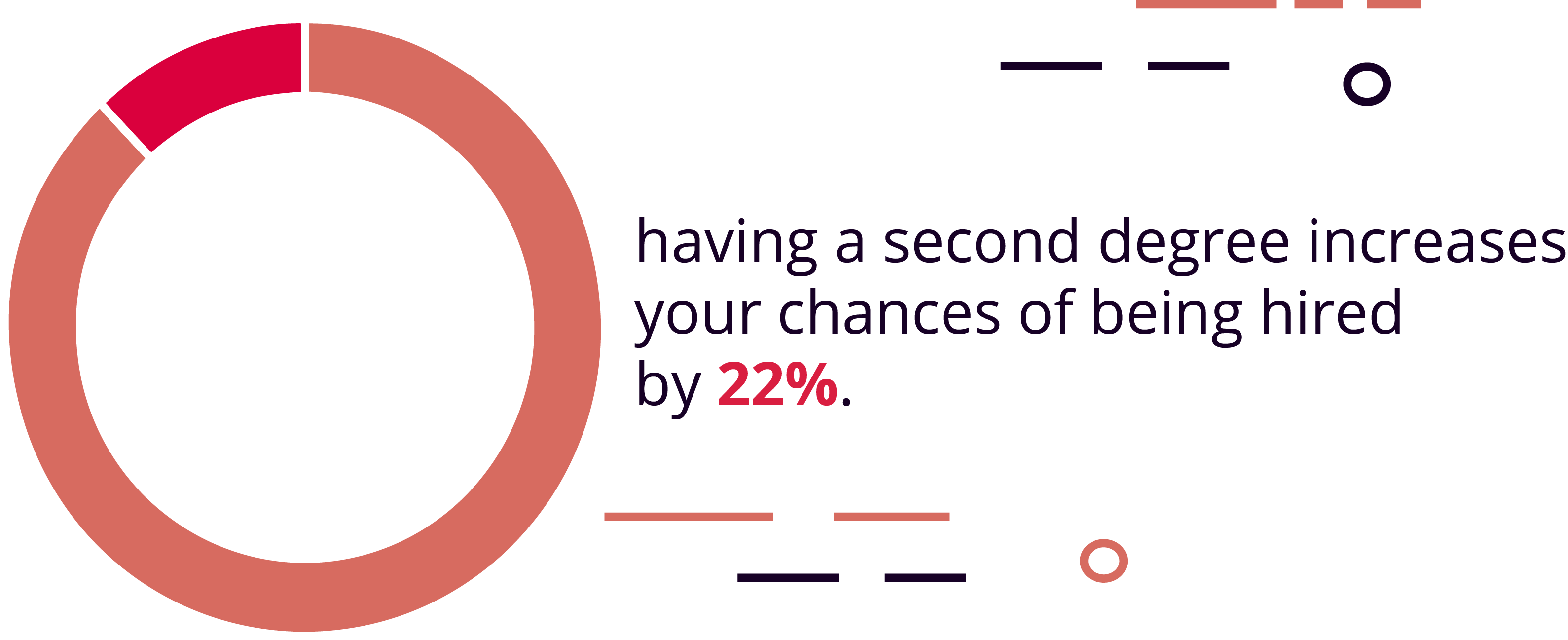
Having a second academic degree boosts your chances of being hired by almost 22% [14].
While not everyone has the luxury of putting their life on hold to pursue a second degree, having a second degree increases your chance of being hired, doesn’t matter what subject the degree is in.
Successfully completing two degrees shows employers that you take your studies seriously and can set goals, commit, and achieve those goals.
Moreover, you likely picked up a lot of good soft skills in school, such as writing, critical thinking, working on group projects, and time-management and organizational skills.
People often emphasize technical skills while forgetting the ever-important transferable skills you learn in school.
27. 25-35 Are the Best Ages to Get Hired

It turns out (perhaps unsurprisingly) that the ages of 28-35 are the best time to get a job [14].
Applicants in this age range are hired 25% more than applicants in other age ranges.
Once you hit 28, your hireability increases by 9% each year until you hit 35, after which your hireability drops by 8% every year.
Here is the trick though; hiring managers estimate your age based on graduation dates. If you don’t put your graduation date or have a few years of work history, they won’t be able to accurately gauge your age. So if you are between 28-35, make sure to list your age on your resume.
If you are younger or older than that span, leave it out, or don’t make it obvious.
28. Women Are 48% More Hireable Than Men

This statistic may come as a surprise to some. It turns out that applicants with obviously female names are hired almost 48.4% more often than male applicants with similar resumes [14].
This trend makes sense. After all, women are outperforming men in school and have made great strides in the workplace in the past 60 years.
Most recruiters tend to be women and there are clear (data-proven) benefits to hiring women and having a more diverse staff.
Women are often underrecognized at work so this data shows that when they do ask for what they deserve, they often get it. So for all the women out there applying for jobs, don’t undersell or underestimate your accomplishments and expertise.
Let recruiters and hiring managers know that you know your worth and won’t settle for anything less.
29. Using Concrete Numbers to Show Accomplishments Increases Chances by 40%

Many work history sections of resumes are clogged with generic vague descriptions of work responsibilities and accomplishments.
There are only so many ways to say “developed client products and managed a team’ before they start to sound the same.
Instead of abstract descriptions and vague generalizations, attach some concrete numbers to your work accomplishments.
Applicants who include concrete numbers related to their performance are 40% more hireable than candidates who do not [14].
Putting definite numbers to your work makes you stand out among candidates and makes it more likely hiring managers will remember your application.
Try to include a figure that demonstrates your accomplishments every 3 sentences.
30. “Team” centered language can hurt your chances of being hired by 50%

Executive and hiring managers go on and on about how they want their workers to be team players. But, when it comes to hiring, do they actually care about how good your teamwork is?
Surprisingly, candidates who include a lot of info about their collaborative efforts get penalized by almost 50% of hiring managers [14].
This is a counterintuitive result, but it likely has to do with how heavily team-focused language offloads your accomplishments and makes it look like you were just along for the ride.
Sure, you say you “collaborated” with a team, but what exactly did you do?
Collaborative language has a passive submissive tone that can reflect negatively on your drive and decision-making skills.
Don’t mention things like “being a team player” more than once or twice in your resume.
Leaving out “collaborative” words increases your chances of being hired by 50%.
31. Applying in The First 4 Days Makes You 65% More Likely to Get a Callback

The early bird gets the worm and the same is true for applying to jobs.
Candidates that apply to positions within the first 4 days of the job posting are 65% more likely to be called in for an interview.
If you apply early, recruiters are more likely to take more time looking through your resume and are more likely to remember you when scheduling interviews.
If you apply to a job a few weeks after the opening is posted, the hiring department has likely combed through hundreds of resumes already and will be less likely to pass yours on to a hiring manager.
After 10 days, your application will likely be tossed into the “resume black hole.”
If you apply after 10 days, you only have a 1.5% chance of hearing back.
In fact, every day you wait to apply your chances of being hired decrease by 28% [15].
32. Over 75% of Resumes Are Discarded by Software

Most recruiters don’t have time to go through every single application on hand, so they rely on programs to sort the wheat from the chaff.
As of 2014, over 75% of submitted resumes are eliminated by bots [16].
These bots look for keywords and phrases and put your application in the recycling bin if they do not see any. You can properly spread keywords throughout your essay to lower your chances of it being discarded by a bot. Don’t overdo it though. Theses algorithms also look for signs of keyword stuffing. So writing a resume to pass the bots can backfire if you are not careful.
33. The Average Interview Length Is 40 Minutes

The average job interview lasts around 40 minutes [16]. So when practicing your interview technique, make sure you have enough material to last at least 40 minutes. It helps a lot if you grab a friend to practice with.
Have them ask you mock interview questions so you can practice and time your responses.
Don’t make a script and try to memorize it, just put together a list of topics and go through them as they naturally come up in the interview.
The worst thing you can do is overwhelm your interviewer and talk too much.
Moreover, you should not prepare your interview spiel as if you were giving a speech for receiving an Oscar.
Keep things simple, professional, and to-the-point.
34. Flashy Layouts Are a Turn off for 22% of Recruiters and Hiring Managers

You may be tempted to put some color or artistic designs in your resume.
While this is fine most of the time, don’t focus on making the layout pretty and forgetting to write relevant information about your skills and job experience.
22% of surveyed recruiters said they found fancy layouts and visual aids distracting [17].
Moreover, applicant tracking software often cannot properly scan resumes with custom layout, so some of your information can be lost in the translation process. So if you absolutely must use charts and data, make sure that all the figures are included in the text of your resume.
35. 43% of Recruiters Prefer Microsoft Word for Resume Submissions

Almost half of respondents said they preferred resume submission in Microsoft Word format, either .doc or .docx [17].
Word documents are useful as they are practically standard now and they allow you to directly edit the document.
Most word processors are compatible with Word files.
Around 23% of respondents indicated they preferred a PDF for resume submissions, and a surprisingly large 26% said that resume format “does not matter.”
Whatever format you use, just make sure that it prints well.
PDFs are particularly useful because they save the format integrity of your resume design. Interestingly, about 2% of surveyed hiring managers said they preferred Powerpoint for resume submissions, a rather unorthodox choice all things considered.
36. A Third of Interviewers Know They Will Hire a Candidate in the First 90 Seconds

Roughly 33% of interviewers report that they often know if they will hire someone in the first 90 seconds of an interview [16].
How could interviewers see enough of candidates to make such a quick decision? Some of the reasons for rejecting candidates given by respondents included:
- Applicant was too flashy/trendy
- Applicant failed to make continual eye contact
- Applicant had little to no knowledge of the occupant
- Applicant failed to smile
- Applicant had a weak handshake
While it may seem unfair that non-verbal things that don’t seem relevant to job performance can prevent you from getting hired, that is the reality of the situation.
That’s why it’s important to practice your interview technique so you are not nervous come the big day.
37. The Average Hiring Manager Has 13 Years of Experience

The average hiring manager has 13 or more years of experience reviewing resumes, giving interviews, and selecting candidates.
About 22% have 5 to 10 years of experience and 20% between 12 months and 5 years of experience [17].
This means that you will most likely have your resume reviewed by an experienced professional who knows what to look for in a good resume.
This also means you can’t rely on hacking your resume to make it more appealing.
Experienced hiring managers can see through that.
Your best bet is to create an organic well-written resume that clearly displays your skills and experience.
38. The Optimal Resume Length Is 2 Pages

Over one-third of surveyed hiring managers said that 2 pages is the optimal length for a resume.
Surprisingly, only 6% of respondents said they preferred a 1-page resume, and 37% responded that resume length did not matter as long as it contains the relevant information [17].
These findings dispel the “one-page” resume myth.
Any length resume should be fine, provided that it is well-written, clearly organized, and has concrete examples of your previous work success.
You should try to shoot for two pages, but don’t get caught up on the length.
39. 650 Words Is the Ideal Resume Word Count

The ideal resume length hovers just over 650 words.
The sweet spot is between 475-650 words [18].
Any more or less and your chances of being hired drop off rather sharply.
Keeping the word count between 475 and 650 words can increase your hireability by almost 75%.
A 475-650 word document can correspond to a densely packed 1-page resume or a more spread out 2-page resume.
There are a few exceptions to this 650-word rule though. If you are an academic, industrial scientist, college professor, school teacher, or social service worker, longer resumes are better.
This makes sense as academics and similar professionals usually have a laundry list of publications, awards, patents, and more.
Shorter resumes are best for applications for business-related positions.
40. Including Resume Objectives Can Hurt Your Chances by 20-67%

It may sound counterintuitive, but including resume objectives does not make you more likely to get hired.
In fact, adding resume objectives can decrease your hireability by almost 30%.
Controlled for experience, applicants who included an objectives section on their resume got 20% to 67% fewer job interviews.
The lone exception to this rule is recent college grads. Job applicants with less than 1 year of experience that included an objectives section got around 7% more interviews [19].
This is not a big gain but it is significant compared to others.
In short, objectives don’t really help because they don’t tell employers much about you.
Your professional objectives are most of the time irrelevant as to whether you can do the job or not, and adding them in just takes up precious page-space that you could use to talk about your accomplishments.
If you have been working for more than a year, leave out the objectives section and go straight into work experience and skills.
41. You Only Need to Meet 50% of the Requirements

Here something you may have seen before: “Project Manager needed. Must have 5+ years of experience, Six Sigma certified, have knowledge of deep learning algorithms and a documented history of assisting in surgeries.”
Every job posting has a small blurb that outlines the requirements for applicants.
But who really can meet all the job “requirements”? As it turns out, very few people!
In fact, you are just as likely to get a job if you meet 50% of the job requirements as you are if you meet 90% [20].
For women, these numbers are 10% lower, 40% and 80%. In general, your chances of getting an interview start to rise once you satisfy about 40% of the requirements.
If you fill 50-60% of the requirements, you are 192% more likely to get an interview than someone who only meets 40%.
42. The Odds of Being Hired from Any One Application Is 0.5-1%

You can prim and preen your resume and iron your interview clothes perfectly but at the end of the day, getting an interview and landing a job is fundamentally a numbers game.
You have to keep taking shots and eventually, you will come out on top.
If you have some experience under your belt, you can probably get an interview about 10%-15% of the time, and you may get a job offer anywhere between 5%-10% for a given interview [20].
Doing the math, that comes out to a measly 0.5-1% chance of getting an interview from a single application.
To bump up your chances to acceptable numbers, you need to apply to anywhere between 150-250 jobs, likely more if you have less experience.
43. Having a Current Job Increases Your Chances by 149%

It is often said that it is easier to get a job when you already have a job.
While that might not be helpful advice to the unemployed looking for work, it is true that being employed makes you more likely to get hired for another job.
Candidates that showed their current employment had a massive 149% hireability boost over unemployed candidates [21].
Even candidates that did not have a traditional job were more likely to be hired if they had some form of employment, no matter how creative.
It is also estimated that being fired decreases your chances of being hired by 43%, equivalent to losing 5 years of professional experience.
This decrease was even larger for candidates over a certain age (40+). So even if you hate your current job and are looking for a new one, don’t quit your job.
Tough it out until you get an offer.
44. 75% of “Entry-Level” Jobs Require 3+ Years of Experience

We have all been in that infamous Catch-22—how can I get a job if I need experience, but I need experience to get a job
According to a TalentWorks survey that covered a random sampling of over 95,000 job openings, over 60% of all full-time jobs described as “entry-level” required at least 3 years of experience [22].
How can this make any sense?
Well, employers are dealing with a so-called “experience inflation” that is causing the amount of required experience to increase by 2.8% every year.
Here is the trick though, you don’t actually have to have 3 years of experience.
Some tricks that help are applying to jobs within 2 years your experience level, building up your resume with freelance work, and finding “real” entry-level jobs that don’t require any experience.
That latter may be hard to find, but they are out there.
45. 25% of Hiring Managers Look at Jobs Lasting Fewer Than 9 Months as Suspicious

Whenever recruiters see a short tenure at a job, they don’t know if its because you got fired (bad), laid-off (potentially bad), or quit (potentially bad).
In general, short job stints look bad on a resume as they could be taken as a sign of unreliability.
25% of hiring managers said that a position held for fewer than 9 months looks very suspicious, and positions held for fewer than 16 months were somewhat suspicious [21].
When writing your employment history, leave off any jobs that you worked for fewer than 9 months, regardless of the reason you left.
Even if your leaving was not your fault, as is the case with lay-offs, hiring managers will still notice the employment blemish which can decrease your chances of being hired.
46. 67% of Small Businesses Offer Flexible Work Arrangements

For millennials, one of the most important things in a job is a flexible schedule.
Unlike previous generations that were content to live the traditional 9-5 work life, millennials value their freedom.
According to business survey data, 67% of small businesses offer employees some form of flexible work, which can include flexible hours worked, remote work, unlimited time off, or casual attire in the office [23].
The same survey indicated that 73% of employees said that flexible work arrangements increase work satisfaction and made them more productive, and 77% of employees consider flexible scheduling a major consideration when evaluating future job opportunities.
47. 69% of Executives Consider Diversity Important for Hiring

According to an employer poll from Deloitte, 69% of company executives claimed that diversity was “very important” concerning hiring decisions [24].
Executives recognize the benefits of a diverse and multicultural workplace.
There is data backing up this belief too; companies in the top quota for gender diversity are 15% more likely to have larger returns than their competitors over similar time scales [25].
However, while executives think diversity is important, only 30% of recruiters hire using policies that are focused on racial and gender diversity [26].
A further 60% of recruiters believe that implicit bias is a real problem in the American workforce.
That is why your resume should reflect a diversity of experiences and connections.
While you do not have control over your race or gender, you do have control over giving yourself a more diverse perspective by listening to the experiences of others.
48. Tech Jobs and Skills Are in High Demand

Based on data from the Bureau of Labor Statistics, jobs in the tech field which include positions like software development, statistics, and mathematics are predicted to grow by 30%, 33%, and 29% respectively [27].
Even if you do not have training in these specific fields, the skills they bring are in high demand in practically every field.
Virtually every job requires one to work a computer, analyze some form of data, and do basic mathematics, so all of these skills are good things to highlight on your resume.
49. 45% of Employers Plan to Increase Salaries for New Hires

Approximately 45% of US employers say they plan to raise salaries for new hires in the next 12 months [28].
More generally, 58% of employers said they planned to increase salaries.
24% of companies plan to raise salaries by 5% or more.
This data is good news for those looking for new jobs as you are likely to get a better starting salary than people who were hired last year.
However, the higher pay also means that competition for those positions will likely be stronger.
50. 91% of Recruiters Believe Soft Skills Are Important to the Future of Recruiting

For a very long time, the US job market has catered towards technical degrees in the STEM and related fields.
While there is certainly merit to these “hard” skills, many employers believe that this focus has been to the detriment of other so-called “soft” skills, like interpersonal management, social skills, communication, and critical thinking.
In fact, according to LinkedIn’s 2019 Global Talent Trends report, 91% of talent professionals believe that soft skills are very important to the future of recruiting [29].
Other domains judged as important are work flexibility, anti-harassment, and pay transparency.
According to Lydia Lie, Head of HR at Home Credit Consumer Finance, “while hard skills may get a candidate’s foot in the door, it’s soft skills that ultimately open it.”
Make sure to include in your resume examples of soft skills you excel at and make sure to touch on those during any interviews.
51. 32% of Workers Plan to Look for New Work in 2019

Unemployment is at its lowest level in years at just under 4%.
This is good news for job seekers as the more people who have jobs, the less competition there will be for open positions.
Don’t breathe too easy just yet though. Around 32% of surveyed employees indicated they planned to look for new work within the next year [30].
The number one reason for looking for a new job was to receive a higher salary, with an inability to advance in their career as a close runner up. So if you are looking for your first job or new work, just know that you will be competing with around 30% of the already employed workforce.
52. 73% of Millennials Found Their Current Job Through Social Media

A whopping 73% of employed millennials (ages 18-34) found their current job through social media websites [31].
This figure makes sense considering that around 95% of recruiters use social media for hiring.
Even though recruiters tend to check LinkedIn the most, less than half of all job seekers (36%) have a Linkedin account and only 14% of that regularly check their accounts.
The most common social media site used by job seekers was Facebook.
Over 80% of job seekers report using the site on a regular basis.
53. 59% of Hiring Managers Discard an Application If It Has Spelling and Grammar Mistakes

Poor grammar and spelling are the number one reason why recruiters disregard an application.
59% of recruiters said that spelling mistakes and grammatical errors were the main reasons why the rejected applications [32].
Other big offenders were writing in the third person, using clip art and emojis, lengthy resumes, and the use of cliches and cringeworthy quotes.
54. Referrals Account for Almost a Third of All External Hires

Referrals account for nearly a third (32%) of all external hirings in all positions [33].
Referrals give recruiters someone who can vouch for your work performance and ethic, which eliminates a lot of guesswork about things that may not be immediately obvious from reading a resume.
This is a major reason why it is incredibly important to keep up to date on your networking and grow your list of professional contacts.
True, some people get lucky and happen to have pre-existing social connections.
For the unlucky among us though, things like job fairs, conferences, and public outreach programs are great opportunities to expand your professional network.
55. A 4-Year Degree Makes You Competitive, According to 87% of Recruiters

While it certainly is true that the utility of a college degree in the job market has dropped in recent years, having a college degree is one of the major factors that can increase your chances of being hired.
Despite the numerous stories you have undoubtedly heard from your college friends, having a 4-year degree does make you qualified for most entry-level positions out there.
87% of recruiters said that a 4-year college degree makes an entry-level candidate competitive in the job market [34].
So make sure you show off that fancy degree you spent hundreds of hours pursuing.
56. 68% of Businesses Report Higher Salaries for New Hires Due to Salary Negotiation

If you do land an interview, then one big thing you need to consider is how much to ask for.
If this is your first job, then you may be hesitant to ask for the full amount you want in fear that you would be asking too much.
This fear is unfounded though. Last year, approximately 68% of businesses reported they increased salary offering for new hires due to negotiations during the hiring process [35].
Contrary to how it may seem, employers are hurting for quality talent so they are willing to pay more than the initial job posting might say.
57. Using Colored Paper Can Hurt Your Chances by Almost 50%

Did you know that even the color paper of your resume can affect your chances of being hired?
It’s true; a study from PSU found that yellow was the most unappealing resume color for recruiters [36].
Specifically, the study found that recruiters were more than twice as likely to judge a resume as bad when it was printed on yellow paper, as compared to white and ivory-colored paper.
Whether this study indicates a particular distaste for yellow or a general distaste for colors in a resume is up for interpretation but the practical conclusions are clear; don’t use colored paper and especially don’t use yellow paper.
58. Using Language in the Job Description Will Help Your Resume Pass Software

You may be initially confused about how to write your resume.
One quick way to figure out is to look at the job description.
Does it have a lot of bullet points? Then use those.
If the job description is more narrative, then make your resume more narrative.
Using the language in the job description makes it more likely for your resume to pass any automated software [37].
59. Small Fonts Decrease Readability by Almost a Third

Small fonts may initially seem like a good idea as they let you stuff more information on a single page of your resume.
However, small fonts can negatively impact the readability of your resume. According to a study from NYU, small fonts under 7.5 increased the reading time of sample text and made it harder for readers to recall information [38].
Granted, this particular study was not conducted in a job recruitment environment, but the findings likely carry over from one context to another.
60. Using Leadership Words Increases Your Chances of Being Hired by Almost 51%

Using leadership-oriented words can improve your chances of being hired by 51% [14].
Words like:
- Communicated
- Coordinated
- Leadership
- Managed
- Organization
Are strong active words that communicate your leadership skills.
Try to incorporate leadership focused words every 5 sentences.
Conclusions
So there you have it, 60 science and data-backed tips that will help you beat the job market.
To be completely honest, the job market is not fair, which is one reason why we put together this list.
You may be perfectly qualified for the job but some small extraneous factors may turn the odds against you.
Above all, remember that finding a job is, at the end of the day, a numbers game.
Even if you follow all of these tips, it will not guarantee that you get the job. At best, these tips will give you a competitive advantage over similarly qualified candidates.
- “Hiring Managers Rank Best and Worst Words to Use in a Résumé in New CareerBuilder Survey.” CareerBuilder, http://www.careerbuilder.com/share/aboutus/pressreleasesdetail.aspx?sd=3/13/2014&siteid=cbpr&sc_cmp1=cb_pr809_&id=pr809&ed=12/31/2014. Accessed 5 November 2019 [↑]
- “The 2015 Recruiter Nation Survey.” Jobvite, https://www.jobvite.com/the-recruiter-nation-survey-2015/. Accessed 5 November 2019 [↑] [↑] [↑] [↑] [↑] [↑]
- Sullivan, John. “Why You Can’t Get A Job – Recruiting Explained By the Numbers.” ERE, 23 July 2015, https://www.ere.net/why-you-cant-get-a-job-recruiting-explained-by-the-numbers/. Accessed 5 November 2019 [↑]
- Shrm. “2016 Human Capital Benchmarking Report.” SHRM, SHRM, 19 May 2017, https://www.shrm.org/hr-today/trends-and-forecasting/research-and-surveys/pages/2016-human-capital-report.aspx. Accessed 5 November 2019 [↑]
- Chakrabarti, Kushal. “The Science of The Job Search, Part I: 13 Data-Backed Ways To Win.” TalentWorks, 6 Apr. 2019, https://talent.works/2018/01/08/the-science-of-the-job-search-part-i-13-data-backed-ways-to-win/. Accessed 5 November 2019 [↑]
- Frost, Aja. “Want Your LinkedIn Profile to Stand Out in 2019? Don’t Include These 10 Overused Words.” HubSpot Blog, https://blog.hubspot.com/sales/want-your-linkedin-profile-to-stand-out-dont-include-these-10-overused-words. Accessed 5 November 2019 [↑]
- O’Donnell, Riia. “Eye Tracking Study Shows Recruiters Look at Resumes for 7 Seconds.” HR Dive, 8 Nov. 2018, https://www.hrdive.com/news/eye-tracking-study-shows-recruiters-look-at-resumes-for-7-seconds/541582/. Accessed 5 November 2019 [↑]
- “Global Recruiting Trends 2018.” Global Recruiting Trends 2018, https://business.linkedin.com/en-au/talent-solutions/recruiting-tips/2018-global-recruiting-trends. Accessed 5 November 2019 [↑]
- Recruiting Software Impact Report, http://www.capterra.com/recruiting-software/impact-of-recruiting-software-on-businesses. Accessed 5 November 2019 [↑]
- Chakrabarti, Kushal. “The Science of The Job Search, Part I: 13 Data-Backed Ways To Win.” TalentWorks, 6 Apr. 2019, https://talent.works/2018/01/08/the-science-of-the-job-search-part-i-13-data-backed-ways-to-win/. Accessed 5 November 2019 [↑] [↑] [↑]
- “18 Scientific Backed Ways to Improve Your Resume (INFOGRAPHIC): Balanced Work Life.” Balanced WorkLife, 19 Oct. 2017, https://balancedworklife.com/18-scientific-backed-ways-improve-resume/. Accessed 5 November 2019 [↑]
- 75% Of HR Managers Have Caught a Lie on a Resume, According to a New CareerBuilder Survey – Sep 14, 2017. Press Room | Career Builder, http://press.careerbuilder.com/2017-09-14-75-of-HR-Managers-Have-Caught-a-Lie-on-a-Resume-According-to-a-New-CareerBuilder-Survey. Accessed 5 November 2019 [↑] [↑] [↑] [↑] [↑] [↑]
- Turczynski, Bart. “Hiring & Recruiting Statistics: Job Search, Interview, Resume Stats 2019.” Zety, 23 Oct. 2019, https://zety.com/blog/hr-statistics. Accessed 5 November 2019 [↑]
- Chakrabarti, Kushal. The Science of The Job Search, Part I: 13 Data-Backed Ways To Win. 6 Apr. 2019, https://talent.works/2018/01/08/the-science-of-the-job-search-part-i-13-data-backed-ways-to-win/. Accessed 5 November 2019 [↑] [↑] [↑] [↑] [↑] [↑]
- Dalton, Rob. “Getting Ghosted On Your Job Applications? Here’s Fix #1: Apply Within 96 Hours.” TalentWorks, 15 Oct. 2017, https://talent.works/2017/09/28/getting-ghosted-on-your-job-applications-heres-fix-1-apply-within-96-hours/. Accessed 5 November 2019 [↑]
- BucklandMartin, Martin, et al. “25 Fun Facts About Resumes, Interviews & Social Recruitment.” Business 2 Community, https://www.business2community.com/human-resources/25-fun-facts-resumes-interviews-social-recruitment-0975676. Accessed 5 November 2019 [↑] [↑] [↑]
- Free Global Hiring Report: Career Directors International. Career Directors, Jan. 2014, https://careerdirectors.com/find-a-career-professional/free-global-hiring-report/. Accessed 5 November 2019 [↑] [↑] [↑] [↑]
- Jaja, Claire. “The Science of the Job Search, Part VIII: Your Chances of an Interview Plummet If Your Resume Is Too Long.” TalentWorks, 10 Jan. 2019, https://talent.works/blog/2018/12/05/the-science-of-the-job-search-part-viii-your-chances-of-an-interview-plummet-if-your-resume-is-too-long/. Accessed 5 November 2019 [↑]
- Chakrabarti, Kushal. “The Science of the Job Search, Part VI: Job Applicants With Resume Objectives Were ~30% Less Hireable.” TalentWorks, 6 Apr. 2019, https://talent.works/2018/05/31/the-science-of-the-job-search-part-vi-do-you-need-a-resume-objective/. Accessed 5 November 2019 [↑]
- Jaja, Claire. “The Science of the Job Search, Part VII: You Only Need 50% of Job ‘Requirements.’” TalentWorks, 6 Apr. 2019, https://talent.works/blog/2018/11/27/the-science-of-the-job-search-part-vii-you-only-need-50-of-job-requirements/. Accessed 5 November 2019 [↑] [↑]
- Chakrabarti, Kushal. “The Science of the Job Search, Part V: Getting Fired (or Laid Off) Costs You ~5 Years of Experience.” TalentWorks, 28 June 2018, https://talent.works/2018/05/02/the-science-of-the-job-search-part-v-getting-fired-or-laid-off-costs-you-5-years-of-experience/. Accessed 5 November 2019 [↑] [↑]
- Chakrabarti, Kushal. “The Science of The Job Search, Part III: 61% of ‘Entry-Level’ Jobs Require 3 Years of Experience.” TalentWorks, 6 Apr. 2019, https://talent.works/2018/03/28/the-science-of-the-job-search-part-iii-61-of-entry-level-jobs-require-3-years-of-experience/. Accessed 5 November 2019 [↑]
- “7 Big Statistics About the State of Flexible Work Arrangements.” Workest, 1 Sept. 2019, https://www.zenefits.com/blog/7-big-statistics-about-the-state-of-flexible-work-arrangements/. Accessed 5 November 2019 [↑]
- “Diversity and Inclusion: The Reality Gap.” Deloitte Insights, https://www2.deloitte.com/us/en/insights/focus/human-capital-trends/2017/diversity-and-inclusion-at-the-workplace.html. Accessed 5 November 2019 [↑]
- “Diversity and Inclusiveness.” EY, EY, https://www.ey.com/en_gl/diversity-inclusiveness. Accessed 5 November 2019 [↑]
- “Global Recruiting Trends 2018.” Careers International, https://www.careersinternational.eu/global-recruiting-trends-2018/. Accessed 5 November 2019 [↑]
- “Home : Occupational Outlook Handbook.” U.S. Bureau of Labor Statistics, U.S. Bureau of Labor Statistics, 4 Sept. 2019, https://www.bls.gov/ooh/. Accessed 5 November 2019 [↑]
- O’Brien, Sarah. “58 Percent of Workers to Get a Pay Raise, Study Shows.” CNBC, CNBC, 3 Aug. 2018, https://www.cnbc.com/2018/08/03/its-a-great-time-to-look-for-a-new-job.html. Accessed 5 November 2019 [↑]
- Facebook. “LinkedIn Releases 2019 Global Talent Trends Report.” LinkedIn Releases 2019 Global Talent Trends Report, https://news.linkedin.com/2019/January/linkedin-releases-2019-global-talent-trends-report. Accessed 5 November 2019 [↑]
- “Forty Percent of Employers Plan to Hire Full-Time Workers This Year, Forty-Seven Percent Recruiting Part-Time Workers – Mar 5, 2019.” Press Room | Career Builder, http://press.careerbuilder.com/2019-03-05-Forty-Percent-of-Employers-Plan-to-Hire-Full-Time-Workers-This-Year-Forty-Seven-Percent-Recruiting-Part-Time-Workers. Accessed 5 November 2019 [↑]
- “11 Social Media Recruiting Statistics to Make You Rethink Your Current Strategies.” Profiles, 20 Sept. 2017, https://www.careerprofiles.com/blog/hiring-innovative-talent/11-social-media-recruiting-statistics-to-make-you-rethink-your-current-strategies/. Accessed 5 November 2019 [↑]
- Deering, Sophie. “Top Resume Mistakes That Could Cost You the Job.” Undercover Recruiter, 26 Jan. 2017, https://theundercoverrecruiter.com/the-top-resume-mistakes-that-could-cost-you-the-job/. Accessed 5 November 2019 [↑]
- Gaenzle, Anthony. “7 Job-Search Statistics You Should Know.” TopResume, 16 May 2017, https://www.topresume.com/career-advice/7-top-job-search-statistics. Accessed 5 November 2019 [↑]
- “2019 Hiring Statistics, Trends & Data: The Ultimate List of Recruitment Stats.” Jobbatical, https://jobbatical.com/resources/hiring-statistics. Accessed 5 November 2019 [↑]
- “50 Recruitment Statistics HR Pros Must Know in 2017.” Devskiller, 1 Apr. 2019, https://devskiller.com/50-recruitment-stats-hr-pros-must-know-2017/. Accessed 5 November 2019 [↑]
- Craig, Hannah. “The Best Fonts to Make Your Resume ATS and Recruiter-Friendly.” Jobscan Blog, 1 July 2019, https://www.jobscan.co/blog/best-fonts-resume-ats-recruiter/. Accessed 5 November 2019 [↑]
- Www.letseatgrandma.com/legresumeservice. “Job Search Psychology: 4 Tips to Gain an Edge – Let’s Eat, Grandma Blog.” Let’s Eat, Grandma | Blog, 2 Aug. 2019, http://www.letseatgrandma.com/blog/job-search-psychology/. Accessed 5 November 2019 [↑]
- “Readability of Fonts in the Windows Environment.” ACM Digital Library, ACM, https://dl.acm.org/citation.cfm?doid=223355.223463. Accessed 5 November 2019 [↑]

